Once upon a time, there was a king named King Hamansa. He had a son named Prince Gursan, who married Princess Khelapari, the daughter of King Gulabsa. After the wedding, Prince Gursan took her home to his father’s palace.
One day, Prince Gursan came home from hunting. He was super tired and really thirsty! It was around lunchtime. He asked Princess Khelapari to get him some water, and while she went to get it, he fell fast asleep. When she came back, he was still sleeping! He slept all afternoon and all night because he was so tired, and didn’t wake up until the next morning. His wife stood by him the whole time, holding the water in a shiny cup. When he woke up and saw that she had been standing there all that time, he felt really bad. He asked for forgiveness and wished that his wife could have anything she wanted, no matter what it was! So, Princess Khelapari wished that she would know everything that happened in the world, even in faraway places, all by herself without anyone telling her.
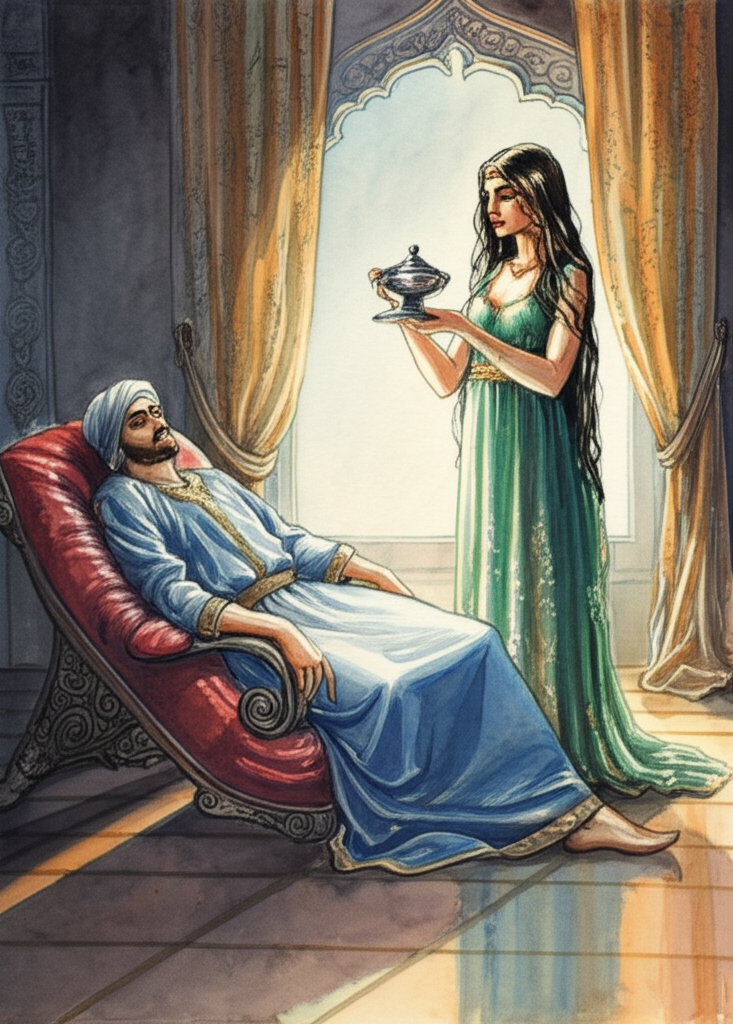
One day, Princess Khelapari went to get water from the pond. By the pond, there was an old man, a wise traveler named Shekh Farid. He asked the Princess, “Can I have a little water to drink?” “Of course!” she said, “But drink it quickly, because my father’s house is on fire, and I need to go put it out!” “How far away is your father’s country?” Shekh Farid asked. “About twenty miles,” Princess Khelapari answered. “How can you know his house is on fire?” said Shekh Farid. “I’ve been a traveler for many years, and I haven’t even known what happens twenty miles away!” “But I know,” she said. “Leave your water jar here,” he said, “and go check if the house is really on fire. I won’t drink until you come back.”
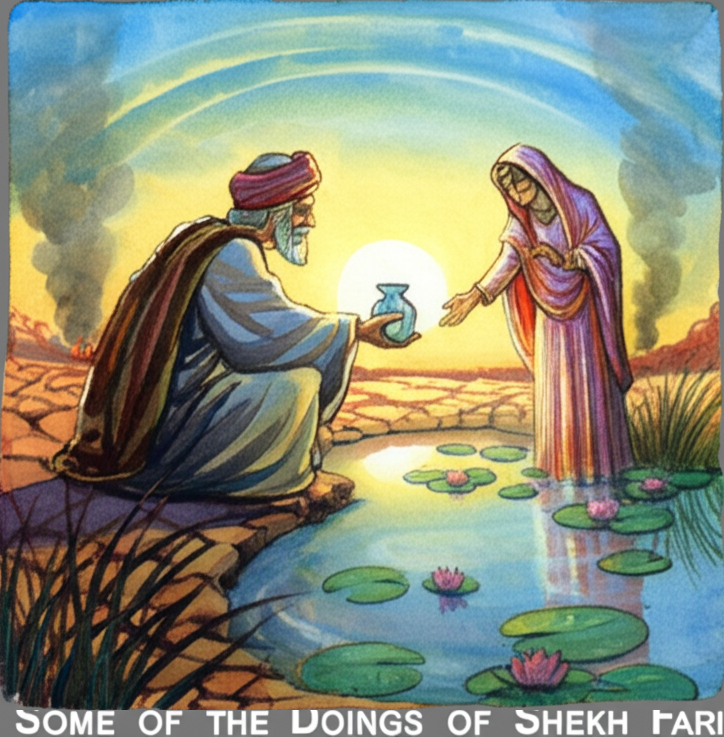
So, Princess Khelapari went all the way to her father’s country. When she got there, his house was really on fire! She stayed until the fire was out, and then went back to the pond where she left the traveler. “Is it true that your father’s house was on fire?” he asked. “It’s true!” she answered. The traveler was amazed. “How could she know when the fire was so far away?” he thought, and he decided to go to King Gulabsa’s country to see if the Princess was telling the truth.
He took a long way to get there because he didn’t know the shortcut. It took him a few days. When he arrived, he asked some people if there had been a fire at the King’s house. “Yes, there was a fire a few days ago!” they answered. The traveler was even more surprised. He decided he would go back to King Hamansa’s palace and ask Princess Khelapari how she knew so much more than him.
On his way back, he saw a cart full of bags of sugar. He asked the driver what was in the bags. The driver was grumpy because his animals wouldn’t move very fast, and he was tired of trying to get them to go. So, he said in a mean voice, “It’s ashes!” “Okay,” said Shekh Farid, “Let it be ashes!” When the driver got to the market and went to give the sugar to the shop owner who ordered it, he saw that all the bags were full of ashes! He was very upset because the sugar cost a lot of money, and he was a poor man. So, he went back to Shekh Farid and begged him, “I’m a poor man! My sugar turned to ashes! Please turn the ashes back into sugar!” “Okay,” said the traveler. “Go home, and you will find sugar. Next time someone asks you what you have in your cart, tell the truth!”
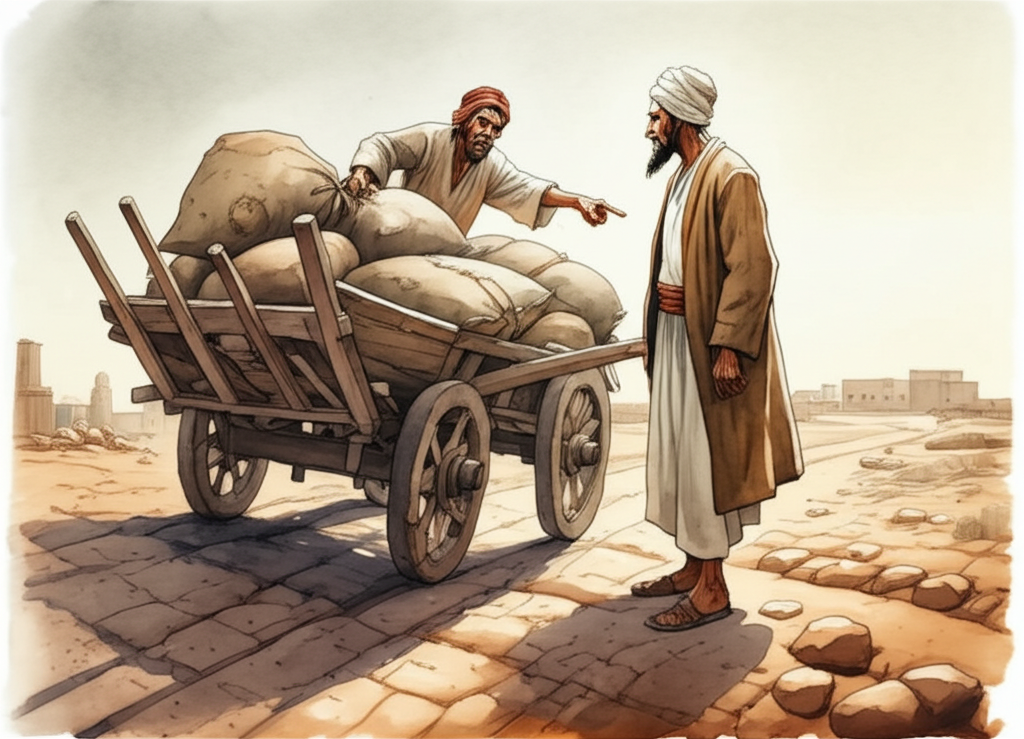
The driver went home, and when he saw his sugar was sugar again, and no longer ashes, he was so happy!
One of the other people in the village thought, “It would be great to be a traveler and do cool things like that! I’ll go learn from this traveler and become a traveler too!” So, he followed Shekh Farid. Shekh Farid knew what the man wanted. As they walked past some clay bricks, he said, “Please let me turn these clay bricks into gold!” Right away, the bricks turned into gold. Shekh Farid kept walking, but the villager picked up two of the gold bricks, one under each arm, and followed the traveler. Suddenly, Shekh Farid turned around and said, “You have two clay bricks under your arms.” The man looked and saw that it was true, they were just clay bricks again! He threw them away. Then Shekh Farid said to him, “You’re stealing bricks, and you want to be a traveler?” The man was ashamed and went back to his village.
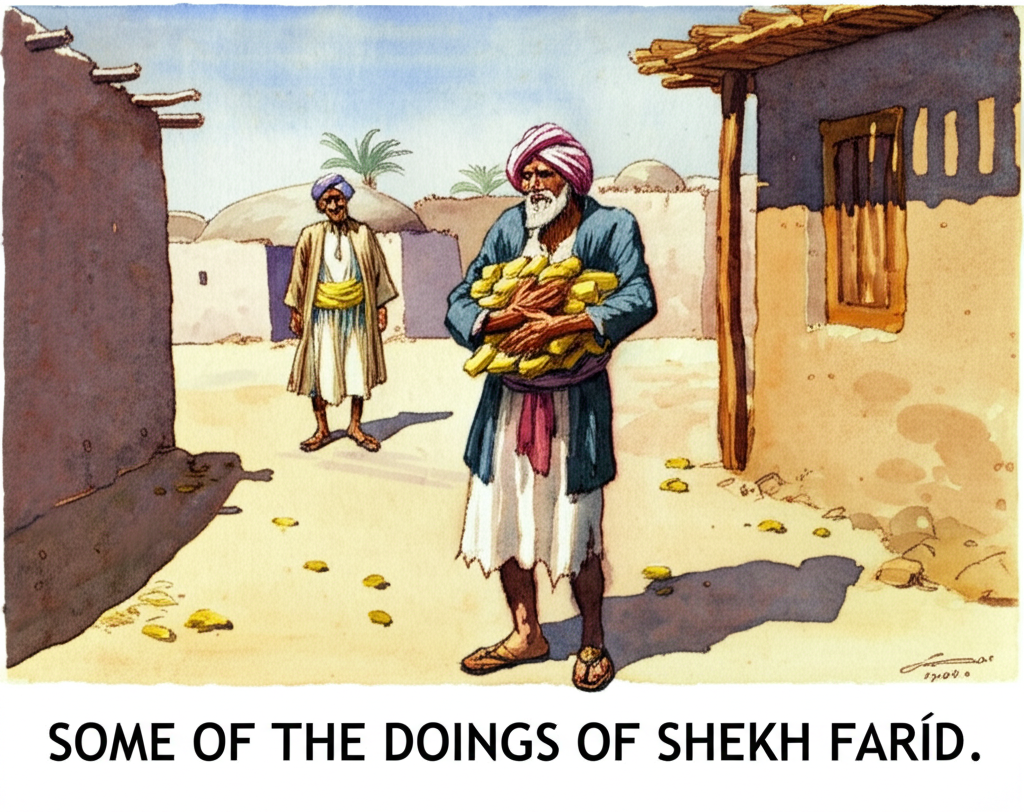
Shekh Farid kept traveling and arrived in King Hamansa’s country. But when he got there, Princess Khelapari was visiting another country. So, he never saw her, and he didn’t find out how she knew what happened twenty miles away.
In a jungle in King Hamansa’s country, he met a man named Fakir-achand and his wife, who were very poor. They were going to bury their only son and were crying a lot. Shekh Farid asked them, “Would you like your son to be alive again?” “Yes!” they said. “Will you give him to me? I’ll bring him back to life, and then he can come back to you,” said Shekh Farid. “Yes!” they answered, and gave him their dead son and went home.
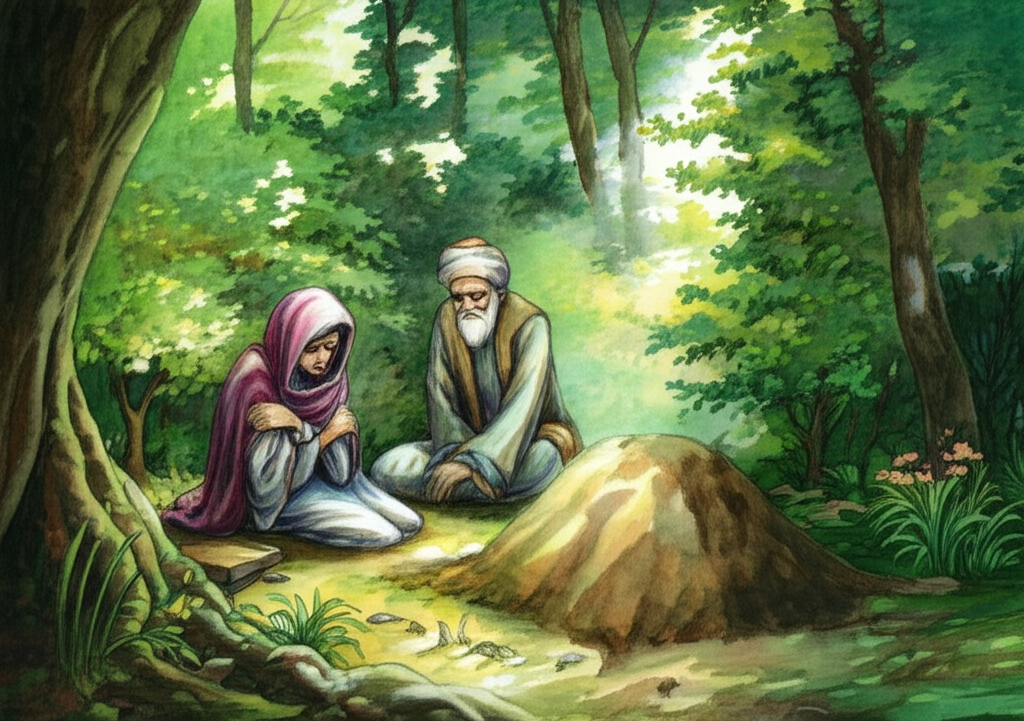
The traveler carried the dead boy, whose name was Mohandas, a little further. Then he put him on the ground and touched him with a long, thin stick he carried. The boy stood up! Shekh Farid asked him, “Would you like to go home to your mom and dad, or stay with me?” “Stay with you!” said Mohandas. (If he had wanted to go home, the traveler would have been angry!) “Then,” said Shekh Farid, “I’ll call your mother here.” He did, and when she came, he said, “See, here’s your son, alive again! Will you let him stay with me for twelve years?” The woman said, “Yes,” and went home. The traveler gave her and her husband some money and built them a nice house. Then he and Mohandas started traveling. They wandered around the jungles for a whole year until they came to a country full of big, beautiful gardens that belonged to a very rich king, King Dumkas.
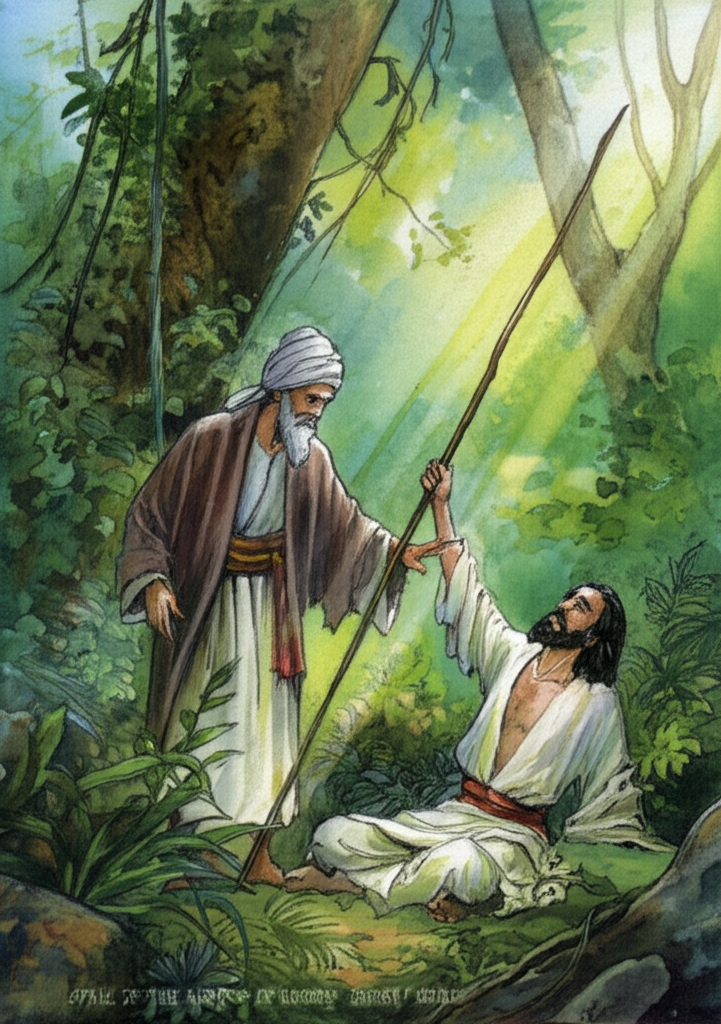
King Dumkas had a beautiful daughter named Princess Champakali. She had pretty golden hair, golden eyebrows, golden eyelashes, blue eyes, and her skin was so clear you could almost see through it! They had never seen a traveler in King Dumkas’s country. So when Shekh Farid and Mohandas arrived, the King sent someone to ask Shekh Farid to come talk to him. “No,” said the traveler, “I won’t go to the King. If the King wants to see me, he has to come to me!”
King Dumkas was very angry when his messengers came back with that answer! He ordered Shekh Farid to leave his country right away. But the traveler said he wouldn’t go until he had Mohandas marry Princess Champakali! Everyone laughed at him for saying that and said that would never happen. But the traveler and Mohandas walked around and looked at the town, and everyone stared at them. Then they went to live near the edge of King Dumkas’s country and stayed there for a while.
One day, Shekh Farid bought Mohandas a beautiful horse and fancy clothes like kings wear. He told Mohandas to ride around in the fields and on the roads. He also told him not to talk to anyone unless they spoke to him first. Mohandas promised he would. As he was riding, he met Princess Champakali, who was also riding. She asked him who he was. “A King’s son,” he said. “Which King?” asked Champakali. “Never mind which King,” said Mohandas. The princess went home, and so did Mohandas. But every day after that, they met and talked, and the princess fell in love with Mohandas.
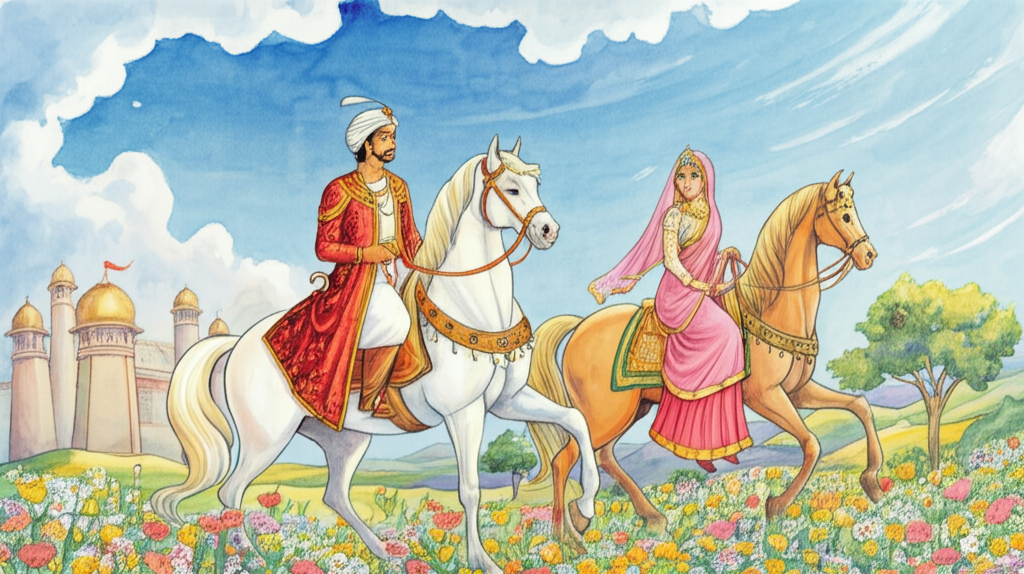
Finally, she said to her father, “I want to marry the young man who rides around near our land every day. He’s very handsome!” The King said yes because it was time for his daughter to get married. No kings from other countries were coming to marry her because scary monsters guarded the princess. They swallowed all the people who wanted to marry her! They had already swallowed many kings who had come to try to marry her.
Shekh Farid said to Mohandas, “Now go up to the palace and ask for the princess to be your wife.” “If I do,” said Mohandas, “the monsters will swallow me!” “I won’t let them swallow you,” said Shekh Farid. So, Mohandas agreed and went to the palace, with Shekh Farid following him. When Mohandas came to the monsters, they tried to swallow him. But the traveler, who had his sword, killed them all! When he did that, all the kings and princes who the monsters had swallowed came jumping out of the monsters’ stomachs! They ran away as fast as they could because they were so scared. They didn’t even know where they were going!
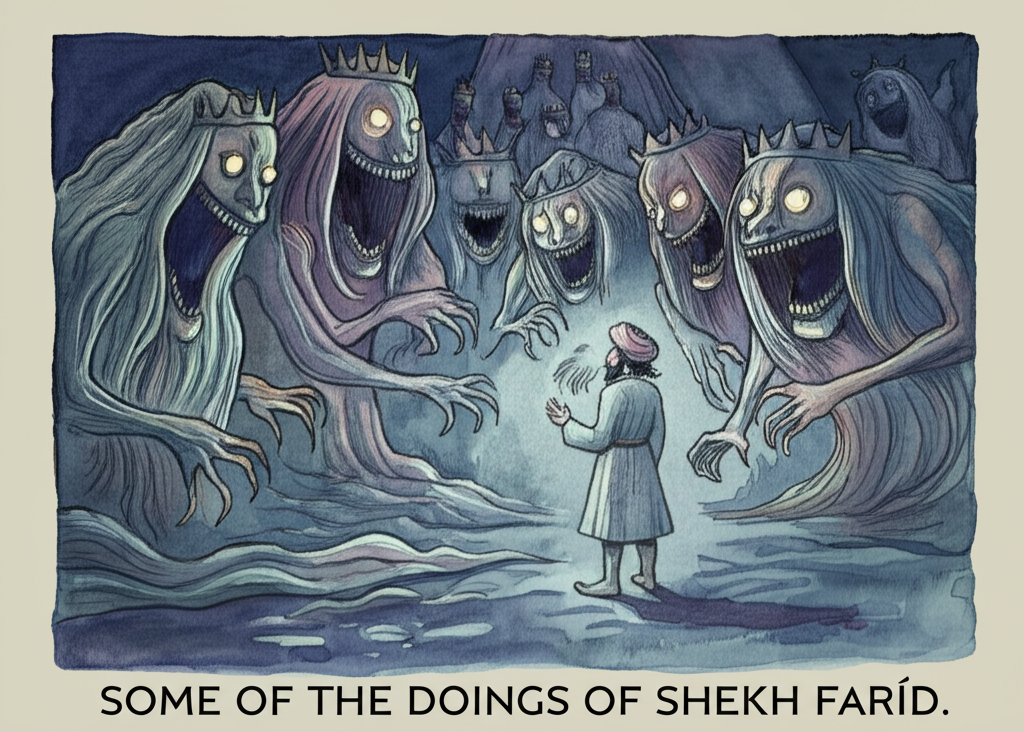
Mohandas was very scared by all of this. But Shekh Farid explained everything to him, so he went on to the palace, and the traveler went too. There, Mohandas asked King Dumkas to let him marry his daughter, and the King agreed! So he married Princess Champakali. Her father gave them lots of elephants, horses, camels, money, and jewels. Mohandas and his wife went with the traveler to his father Fakir-achand’s house. They took all the elephants, camels, horses, money, and jewels with them. On the way, Mohandas told Princess Champakali that he wasn’t really a king’s son. He was the son of poor people. Champakali felt sad when she heard that, but she wasn’t angry, just a little sad.
When they got to King Hamansa’s country and reached Fakir-achand’s house, the traveler said to Mohandas’s mother, “You let me borrow one child, and I brought you back two children! Are you happy about that?” “Yes, I am!” she answered. “I’m very happy!”
They built a beautiful palace and all lived in it together. The mother asked Shekh Farid to stay with them, saying, “Please stay with us! I’ll give you a little house, and you can have anything you want!” But Shekh Farid said, “I’m a traveler, so I can’t stay in one place. I have to wander from country to country and jungle to jungle.” So, he said goodbye to them and went on his adventures. He never came back.
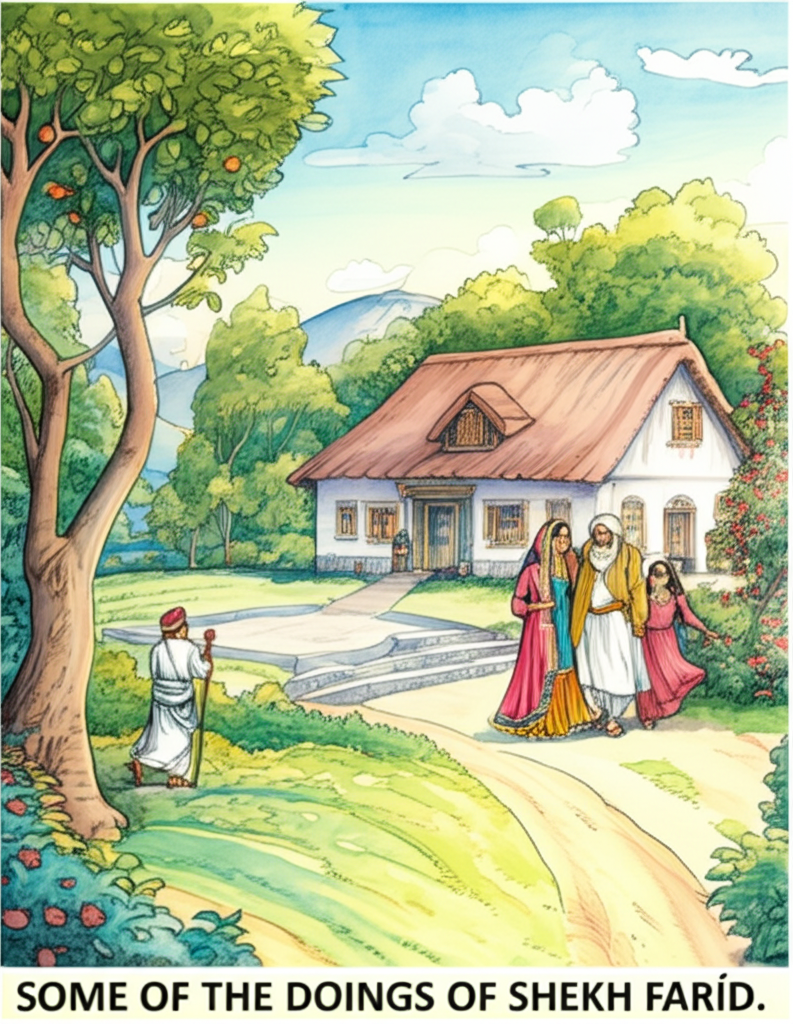
Mohandas, his wife, and his mom and dad all lived happily ever after.